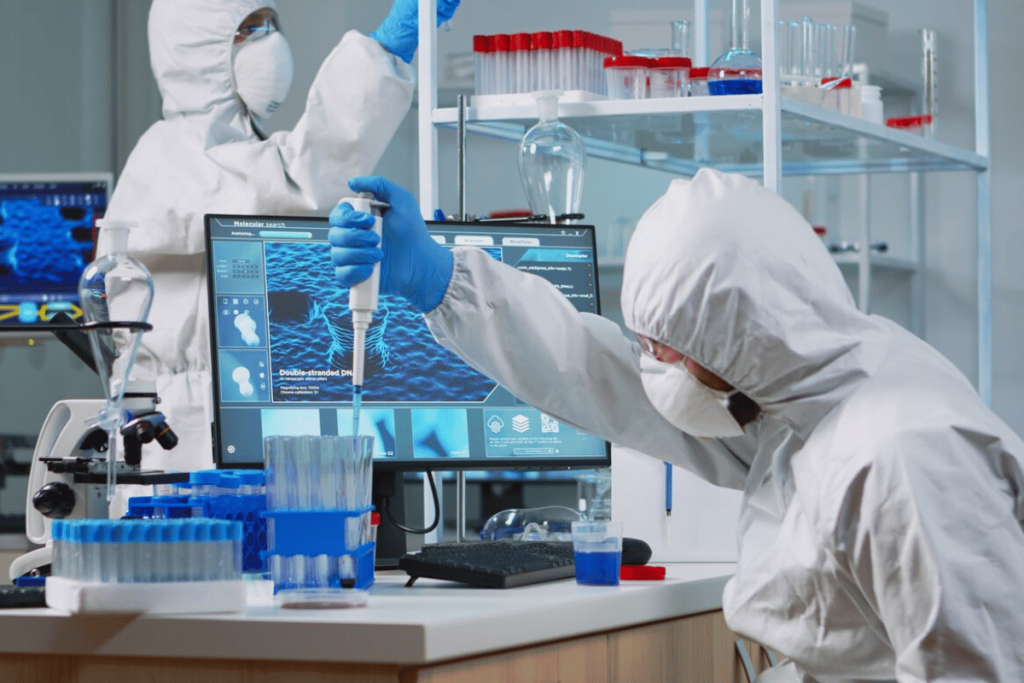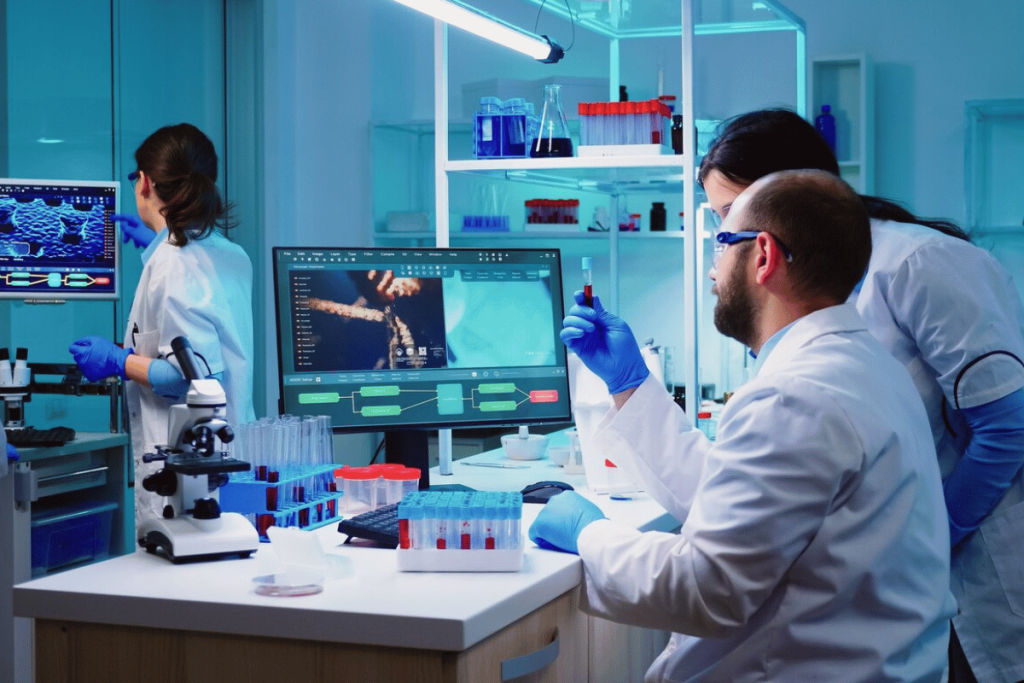Biotech Valuation Methods (Explained)
Trying to put a price on a biotech company can seem as hard as finding a cure for the common cold. Many biotech firms don't even have products yet, just dreams of making the next breakthrough medicine.
But figuring out what they're worth matters big time when these companies need funding.
This article will walk through how pros value biotech startups. We'll look at what makes biotech valuation tricky, essential things that impact value, standard ways to put a price tag on pre-revenue biotechs, and some real-world examples.
Let's get started!
Biotech Valuation: An Overview
Biotech companies are in the healthcare innovation business. They use science and tech to develop new solutions like gene therapies, cancer immunotherapies, and tailored medicine.
But this vital research takes many years and tons of money before it might pay off. In fact, one study from Deloitte found that developing just one approved drug costs over $2.3 billion on average!
So, even with no sales, biotech startups can get giant investments by showing promise in their pipelines. But how do you measure the value of pipeline potential? Well, valuing pre-revenue biotech companies can be challenging.
First, let's get an overview of how biotech valuation works at a high level.
Understanding biotech valuation multiples
Multiples like P/E don't work well for biotech firms with no earnings. However, some analysts look at multiples like EV divided by R&D expense to compare companies.
Another metric commonly examined is the enterprise value (EV) to revenue multiple. This ratio divides a company's enterprise value - market capitalization plus debt - by its annual revenue.
When investors pay a higher multiple for a company, it means they think it could earn a lot more money in the future, even if it's not earning huge profits right now.
Biotech companies often get higher multiples because investors get excited about their future prospects. In 2023, the median EV to revenue multiple for biotechnology companies sat at 12.97x.
Over the past two years, some companies attained valuation multiples surpassing 20 times revenue. A select few exceptional firms even reached staggering multiples approaching 100 times revenue!
Multiples are rough gauges. Since each biotech is so different, valuation is highly company-specific. We will expand on this concept in greater detail in the forthcoming sections.

What is a pipeline in biotech companies?
A biotech company pipeline is all the company's medical treatments in development. It includes -
New treatment ideas they are researching early on (Primary research).
Experiments testing treatments on cells and animals (Preclinical testing).
Patient studies to see if treatments are safe and effective (Clinical trials in people - this is broken into 3 phases).
Pipelines run all the way through FDA approval and product launch.
How do pipelines affect valuations in biotech?
The pipeline is the key thing that makes a biotech company valuable. The more stuff they have in development, the more shots at success adding to a biotech's risk-adjusted net present value (rNPV).
More pipeline programs mean more chances at big winners down the road. And programs in later testing stages further along the pipeline will likely make it.
Investors get excited to bet on pipelines based on things like:
The number of treatments being tested - more spreads out risk.
How new or different is the science? More innovation seems promising.
The potential market size, if approved - bigger markets mean more sales.
How well testing is going so far - strong early data impresses.
Whether the managers have done this before - seasoned leaders add trust.
So companies with many treatments, especially ones in final stage testing, can get much bigger valuations and funding amounts. Their pipeline suggests bigger future moneymakers coming.

3 Key Factors Influencing Biotech Valuations
There are a few core elements that impact biotech valuations, especially for startups without sales yet.
1. Latest trends and insights
The biotech scene is constantly changing as new breakthroughs happen. Valuations consider recent advances, deals, regulatory shifts, and surprises hinting at where the industry is headed.
For instance, cell and gene therapy valuations have risen recently thanks to considerable progress in these areas. However, setbacks in Alzheimer's trials have made investors more cautious about neurodrug developers.
Staying up-to-date on the biotech landscape gives perspective on current benchmark valuations.
2. Previous deals in the industry
Looking at previous biotech sales and licensing deals also hints at what companies could be worth.
For instance, say another company had a medicine in testing targeting the same disease as yours. Seeing the early and success-based payments in their past partnership puts numbers around value.
Every deal is, of course, unique. But checking what prices, deals, and terms have been swallowable for biotech buyers lately shines light.
It helps answer the question: "What checks have investors recently been willing to write for companies like mine?" Eyeing the norms through peers lays the groundwork.
3. Market sentiment and investor interest
General investment trends also impact biotech valuations. When money is flowing freely, investors may accept higher risk. In slowdowns, funding may tighten or shift towards later testing phases.
And specialist biotech VC and PE firms may grant premium valuations thanks to their insider expertise. In contrast, generalist investors new to biotech may undervalue compared to experienced sector investors.
For more background on standard valuation approaches used by venture capitalists and other investors, see this ExitWise article on how to value a business.

How to Value a Biotech Company
Alright, now let's look at the main ways investors value development-stage biotech firms:
Risk-adjusted Net Present Value (NPV) Approach
When deciding if an investment like a new drug is worthwhile, companies want to estimate how much money it could make in the future if it succeeds.
But there's always uncertainty - the drug might not make it through all the clinical trials or get approved. So they have to account for that risk.
The risk-adjusted NPV approach is a way to calculate that. It estimates the value of a biotech company's pipeline drugs while accounting for the risk and uncertainty involved in drug development.
It starts by looking at the different phases of clinical trials (Phase 1, 2, 3, etc.) that a drug must pass through before approval. At each stage, there is a risk that the drug will fail and not make it to the next phase.
Historical data shows the percentage of drugs that typically pass each phase. For example -
Phase 1 trials have around a 75% success rate
Phase 2 around 50%
Phase 3 around 58%
These percentages are called the "probability of success" or "POS."
For each pipeline drug, potential future cash flows are estimated under different scenarios - one where it passes Phase 1, one where it passes Phase 2, and so on until approval.
These cash flow scenarios are risk-adjusted by multiplying them by the POS at each step.
The risk-adjusted cash flows are then discounted to the present, using an appropriate discount rate based on the company's cost of capital. This gives the "risk-adjusted net present value," or rNPV.
Summing up, the rNPV of all pipeline drugs estimates the company's overall value. The rNPV approach accounts for the inherent uncertainty in biotech R&D. It uses historical POS rates that may differ across drug types and development phases.
This allows more realistic valuation versus simpler discounted cash flow models.
An article published in the Journal of Open Innovation analyzed clinical trial data to calculate POS and drug development timelines. It proposes an improved rNPV model incorporating these drug-specific parameters.
This could lead to more accurate biotech valuations and investment decisions.

Discounting to Risk-adjusted NPV Approach
Rather than adjusting possible future revenue scenarios for risk, another technique is to apply higher discount rates early on.
Think of the discount rate as an interest rate. It lets you estimate what future money is worth today. Just like you would need a higher interest rate to accept more risk with your savings account, companies use higher discount rates on risky drug investments.
A new drug is very uncertain in the early testing stages so companies will use a very high discount rate, like 50% or more. That heavily reduces the value they put on the possible future cash flows today.
But as the drug advances through clinical trials and the risk decreases, the discount rate used also decreases. By the time the drug nears approval, the company may use a discount rate of just 10-15%, like calculating the value of any other company.
Here's a simple step-by-step of the approach:
Estimate the total peak sales the drug could generate in a year if eventually successful.
Forecast the total revenues minus costs over a typical 10-year exclusivity period. This gives the possible future cash flows.
Apply a discount rate to those cash flows based on the investment risk. The higher the risk, the higher the discount.
The discounted cash flows are summed to give a risk-adjusted net present value for deciding if the investment is attractive.

Real Options Valuation
Standard valuation methods like DCF have a big blindspot - they fail to quantify executives' power to make tactical decisions. DCF simply predicts single revenue scenarios.
Real options valuation is an approach that treats business investments as "options" rather than static projects.
Just like financial call options give the holder the right but not the obligation to buy an asset in the future, companies make investments that give them a chance to capitalize on opportunities in the future.
This approach is very relevant for biotech companies developing new drugs or treatments. The R&D process is lengthy and uncertain, and managers can choose to -
Expand successful trials into additional uses
Kill failed studies to conserve cash
Pivot teams into more promising areas
Each of these represents an "option" that has tangible value. Real options valuation aims to quantify these options.
For example, securing patents, conducting clinical trials, or building production facilities are costly investments. Still, they allow the company to retain the option to eventually commercialize a new drug and claim returns on their investments.
Without those initial investments, the company would lose the potential upside of bringing a successful drug to market.
Real options valuation uses models and simulations to value these "compound options" within development projects. It provides a more flexible and risk-adjusted view than simpler net present value models used in capital budgeting.

Comparable Company Analysis
Comparable company analysis is another method companies use for early-stage biotech startup valuation and drug pipeline evaluation. The core idea is to benchmark the investment against public biotech companies at a similar stage of development.
Specifically, you look at trading multiples like:
Enterprise Value to R&D Expense Ratio (EV/R&D ratio)
This compares the total value investors put on the company to how much it spends on research. A high multiple signals investors expect promising pipeline productivity from R&D.
Enterprise Value to Phase 3 Drugs Ratio (EV/Phase 3 ratio)
This specifically values late-stage pipelines against total company value. More advanced Phase 3 assets should warrant higher multiples.
You can estimate a reasonable valuation range by applying these same multiples from comparable public biotechs to the startup.
For example, if public RNA therapy biotechs trade at 10x annual R&D spend, an intriguing startup with $20 million invested may merit $200 million pre-money.
However, truly comparable peers are scarce. Each biotech varies in specialization, pipeline maturity, IP protection, and addressable markets.
Another downside is that private company drug pipelines tend to get discounted by 30-50% vs public peers. Investors apply cuts because pipelines lack market validation and liquidity until IPO.
With limitations, this biotech valuation model is often used alongside DCF models and real options methods discussed earlier.

Monte Carlo Method
Predicting the future value of a new biotech company involves a lot of uncertainty. How much revenue will their drugs produce? What will expenses look like? Making guesses can give you a valuation but not the whole picture.
That's where Monte Carlo simulations come in handy. The name sounds complicated, but the idea is simple:
Take your predictions about revenue, costs, drug trials, etc.
Run thousands of scenarios where you tweak those numbers up and down randomly. Some trials fail, and some succeed beyond expectations. Expenses vary.
See the whole range of outcomes - best case, worst case, and everything in between.
Running all these simulations is like seeing parallel futures for the company. You can then see not just one valuation prediction but the odds of different outcomes based on how uncertain things are today.
It's a clever way to quantify the uncertainty that makes biotech investing tricky. The simulations reflect the real-world risk that plans don't work out as hoped.
For example, simulations may show that:
Reaching 60% of suitable patients is necessary for profitability.
Peak pricing below $150,000 makes the drug less commercially viable.
Clinical trials have very binary pass/fail odds that make or break the value.
Such insights help managers strategic resource allocation to maximize outcomes.
The downside is that Monte Carlo analysis takes some complex financial modeling to set up. So, while it gives valuable insights, most biotech valuations don't go into this level of detail.

Scorecard Valuation Method
Financial models have a narrowness problem. They fixate forecasts on envisioned revenues and earnings. But other less quantifiable attributes critically impact biotech success.
Scorecard valuations tally the total talent points across vital areas like:
Team - Do serial entrepreneurs and scientists lead?
Data - How strong are early trial results?
IP - What patent protection exists?
Milestones - Were growth targets achieved?
Each factor receives points reflecting its strength.
100 for highly experienced leadership.
75 for encouraging animal data.
50 for provisional patents; and
25 for software IP alone.
Weighting score categories on their value impact allocates importance. For an early-stage biotech, proven team expertise likely outweighs milestones reached. So, management would secure a higher factor weighting.
Summing across weighted scores produces a total valuation gauge. While still subjective, this method assesses oft-ignored human and operational attributes underlying success.
Scorecards also allow customization across biotech niches. An oncology startup may weigh trial results highest with a 50% weighting, while an autoimmune gene therapy developer may emphasize IP and team more.

Venture Capital Valuation Method
Unlike typical tech startups, biotech companies face much longer development timelines before reaching commercial viability and revenue. They also have binary risk around clinical trials - their main drug asset either works or fails.
As such, VCs use specialized valuation models for biotech startups (that do not have established cash flows yet) to account for long time horizons and binary risk. The most common model is probability-weighted rNPV models with large discounts.
The steps are:
Project peak annual sales potential of the biotech's lead drug compound if clinically successful.
Estimate total addressable patient population and penetration rate to derive yearly revenue forecast model.
Factor in product development timeframe to map clinical trial milestones and estimate years to peak sales.
Account for the probability of clinical success - this "risk adjusts" revenue downwards.
Calculate COGS, R&D spend, and SG&A costs to model net cash flows.
Apply a high discount rate of 40-60%+ on future cash flows - this also accounts for clinical binary risk.
Sum discounted cash flows to derive risk-adjusted net present value (rNPV).
The resultant rNPV effectively estimates what the biotech asset could be worth years in the future if clinically successful, but risk and time adjusted to today's value. This becomes the core driver of biotech startup valuation for VCs.
Upside leveraging and staged financing are also vital tools VCs use to mitigate risks and project higher potential returns despite accounting for high probabilities of clinical failure, even at large discounts.

How to Value Pre-revenue Biotech Companies
New biotech companies often don't have products on the market yet. So, how do you estimate what they could be worth? You have to assess their potential.
Experts look at five key areas:
1. Science
Does the drug target a vital mechanism related to disease? How novel is the approach compared to competitors? Strong science gives confidence the drug will make it through testing.
2. Market
How many patients could benefit from the drug? Bigger markets offer greater revenue potential if the drug succeeds.
3. Data
Early-stage safety and efficacy data provides clues about the drug’s promise. Robust data increases the likelihood of success.
4. Team
Have the executives and scientists successfully developed drugs before? Experience matters in biotech.
5. Milestones
Can the company complete the necessary preclinical and clinical testing steps? Hitting development goals on time predicts success.
If approved, these subjective factors guide financial projections about a drug’s peak sales. But there’s still lots of risk.
Valuing Potential
First, estimate the drug’s peak annual sales if approved.
Then, calculate the drug’s estimated free cash flows - peak sales minus expenses and taxes. Multiply the estimated free cash flows by the probability the drug succeeds based on what stage it's in (preclinical, Phase 1, 2, or 3 testing).
That gives expected cash flows adjusted for risk. Project them over 10 years and discount those long-term cash flows back to today’s dollars.
Discounting to present value accounts for the time value of money and reflects the risk that the drug never makes it to market.
This complex valuation approach involves significant assumptions but frames the valuation discussion. Financial models get refined as drugs progress and risks decrease.
Of course, most biotech entrepreneurs are scientists focused on R&D, not valuation experts. This is where trusted partners can help.
ExitWise streamlines the process of assembling specialized finance teams to advise on M&A or licensing transactions.
Our network of top investment bankers, lawyers, and accountants brings deal-making and valuation expertise tailored to each client’s situation and objectives.

Examples of Biotech Valuations
Let's look at some real-world biotech valuation examples:
Legend Biotech
Cell therapy leader Legend Biotech raised $150.5 million in Series A financing when it went public in 2020. The company had no approved products yet but was testing an advanced BCMA CAR-T therapy for multiple myeloma.
Investors valued its fast-moving pipeline.
As of December 2023, Legend Biotech is developing advanced cell therapies across diverse technology platforms, including CAR-T cell therapy, and has a global manufacturing infrastructure.
Seagen
Pfizer purchased the antibody-drug conjugate leader Seagen for $43 billion in December 2023. Seagen had four FDA-approved ADC cancer drugs, including Adcetris, Padcev, Tivdak, and Tukysa.
The deal valued Seagen's proven ADC technology and expanded pipeline, doubling Pfizer's oncology products to 60, including 9 current or potential blockbusters. It positions Pfizer to lead next-generation cancer breakthroughs.
Biotech Valuation Calculator
ExitWise offers a free online valuation calculator that gives fast initial enterprise valuation estimates for private companies.
The calculator has just 3 key steps:
Select the industry vertical.
Input the last 3 years of financials - annual revenue and EBITDA (earnings).
Enter projected growth rates and operations information.
Based on these inputs, it benchmarks against public companies and shows a valuation range using standard multiples like EV/Revenue and EV/EBITDA.
It's meant for quick ballpark estimates. ExitWise's paid report builds DCF models for more customized valuations based on additional operational details.
But the free calculator is an easy starting point to sanity check estimates from other valuation methods.

Frequently Asked Questions (FAQs)
Let's review some common biotech valuation questions:
What is the Mean Exit Value for Biotech Firms?
The mean exit value refers to how much money biotech companies are worth, on average, when they either get acquired by another company or go public through an IPO. Essentially, it's how much the companies sell for.
The key thing to understand is that biotech exit values are "bimodal" - meaning they generally fall into one of two very different categories:
Many biotech companies fail and sell for very little or go out of business.
But a select few succeed and sell for billions of dollars through huge acquisitions or IPOs.
According to one industry report from 2015-2020, the middle half of exited biotech companies sold for 2-13 times the amount initially invested into them. Across all exited biotechs, the average multiple was 4.5x the money invested.
What is Meant by the Seed Valuation of a Biotech Company?
The seed valuation is the company value set in an early financing round, usually under $5 million. For strong biotech startups, seed valuations can range from $5-$15 million.
What is the WACC for Biotech Companies?
WACC is the weighted average cost of capital. It refers to the average rate of return that investors require from investments in a company based on the relative mix of debt financing and equity financing used.
For established pharmaceutical giants, investors usually require 10-15% return rates.
However, biotech investments are seen as much riskier by investors. So, the average return rate investors demand (the WACC) from biotech firms is around 12.5% or higher.

What is the Average Valuation of a Biotech IPO?
In the past few years (2018-2021), biotech companies going public had an average fully diluted valuation of $827 million (median = $618 million).
However, in 2022 and early 2023, investor appetite for risky biotech IPOs has declined significantly. As a result, recent biotech IPO valuations are much lower - averaging around $123 million in 2022.
In 2023 (till September), the average amount raised in biotech IPOs was approximately $140 million (for the 19 offerings we know of).
This signals that investors are being much more selective and conservative with new biotech offerings compared to the bull market years prior.
How Do Early-stage Biotech Valuations Differ From Late-Stage?
Early-stage biotech valuations tend to be lower (often sub-$50M) but are more based on subjective potential. Late-stage valuations can reach billions based on clinical data and commercial prospects. However, the early stage offers higher upside potential.
Conclusion
Figuring out what development-stage biotech firms are worth is tricky. However, taking both a quantitative and qualitative approach allows investors to gauge pipeline promise and derive reasonable valuations, even with minimal data.
If you aim to sell or merge your biotech startup, you can get help setting an optimal valuation and exit strategy. ExitWise connects you with hand-picked merger and acquisition experts suited to your specific sector and goals.
These teams advise on deals optimized for where you want to take your company.
So, if you are seeking an optimal outcome for your blood and sweat, visit ExitWise's contact page to learn more. Specialist guidance maximizes your valuation and strategic direction during dealmaking.

